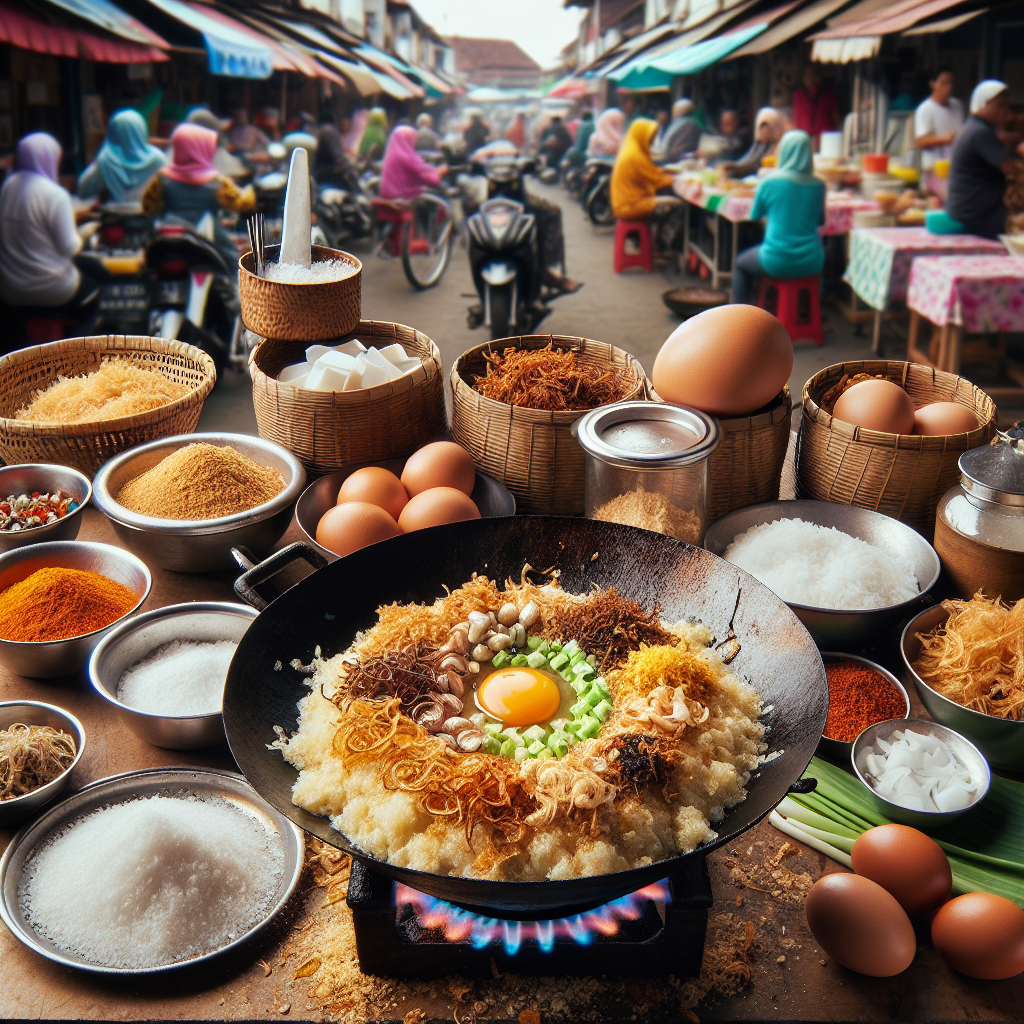-
Table of Contents
- Introduction
- The History of Kerak Telor Betawi
- The Ingredients
- 1. Glutinous Rice
- 2. Duck or Chicken Eggs
- 3. Dried Shrimp
- 4. Shredded Coconut
- 5. Spices
- The Preparation
- 1. Soak the Glutinous Rice
- 2. Prepare the Spices
- 3. Toast the Shredded Coconut
- 4. Cook the Rice and Egg Mixture
- 5. Cook on a Charcoal Stove
- 6. Flip and Repeat
- Conclusion
Introduction

Indonesia is a country known for its rich culinary heritage, and one dish that stands out among the rest is “Kerak Telor Betawi.” This traditional Betawi dish is a unique combination of flavors and textures that has been enjoyed by locals for generations. In this article, we will explore the history, ingredients, and preparation of this authentic Kerak Telor Betawi recipe.
The History of Kerak Telor Betawi
Kerak Telor Betawi originated from the Betawi people, who are the indigenous inhabitants of Jakarta, the capital city of Indonesia. The dish has a long history that dates back to the 17th century during the Dutch colonial era. It was initially created as a snack for the Betawi nobility during the annual festivities of Jakarta’s anniversary.
The name “Kerak Telor” translates to “egg crust” in English, which perfectly describes the dish. It is made by combining glutinous rice, duck or chicken eggs, dried shrimp, shredded coconut, and various spices. The mixture is then cooked on a charcoal stove until it forms a crispy crust.
The Ingredients
To make an authentic Kerak Telor Betawi, you will need the following ingredients:
1. Glutinous Rice
Glutinous rice is the main ingredient in Kerak Telor Betawi. It is a type of rice that becomes sticky when cooked, giving the dish its unique texture. The rice needs to be soaked in water for a few hours before cooking to ensure it cooks evenly.
2. Duck or Chicken Eggs
Traditionally, Kerak Telor Betawi is made with duck eggs. However, chicken eggs can also be used as a substitute. The eggs are beaten and mixed with the glutinous rice to create the crust.
3. Dried Shrimp
Dried shrimp adds a savory flavor to the dish. It is usually ground or finely chopped before being added to the mixture.
4. Shredded Coconut
Shredded coconut is another essential ingredient in Kerak Telor Betawi. It is toasted until golden brown and then mixed with the rice and egg mixture.
5. Spices
Various spices are used to enhance the flavor of Kerak Telor Betawi. These include shallots, garlic, candlenuts, coriander seeds, and white pepper. The spices are ground into a paste and added to the mixture.
The Preparation
Now that we have discussed the ingredients, let’s move on to the preparation of Kerak Telor Betawi.
1. Soak the Glutinous Rice
Start by soaking the glutinous rice in water for at least 4 hours. This will ensure that the rice cooks evenly and becomes sticky.
2. Prepare the Spices
While the rice is soaking, prepare the spice paste. Grind shallots, garlic, candlenuts, coriander seeds, and white pepper into a fine paste using a mortar and pestle or a food processor.
3. Toast the Shredded Coconut
In a dry pan, toast the shredded coconut over medium heat until it turns golden brown. Stir constantly to prevent burning. Once toasted, set it aside.
4. Cook the Rice and Egg Mixture
In a large bowl, beat the duck or chicken eggs and mix them with the soaked glutinous rice. Add the ground spices, dried shrimp, and toasted shredded coconut. Mix well until all the ingredients are evenly distributed.
5. Cook on a Charcoal Stove
Traditionally, Kerak Telor Betawi is cooked on a charcoal stove to achieve the perfect crust. Heat a small pan or skillet over medium heat and grease it with a little oil. Pour a portion of the rice and egg mixture into the pan and spread it evenly. Cook until the bottom becomes crispy and golden brown.
6. Flip and Repeat
Once the bottom is cooked, carefully flip the Kerak Telor Betawi using a spatula. Cook the other side until it forms a crispy crust as well. Repeat the process until all the mixture is used.
Conclusion
Kerak Telor Betawi is a beloved traditional dish in Indonesia that represents the rich culinary heritage of the Betawi people. Its unique combination of flavors and textures makes it a favorite among locals and tourists alike. By following the authentic recipe and using the right ingredients, you can recreate this delicious dish in your own kitchen. So why not give it a try and experience the taste of Indonesia’s cultural heritage?
